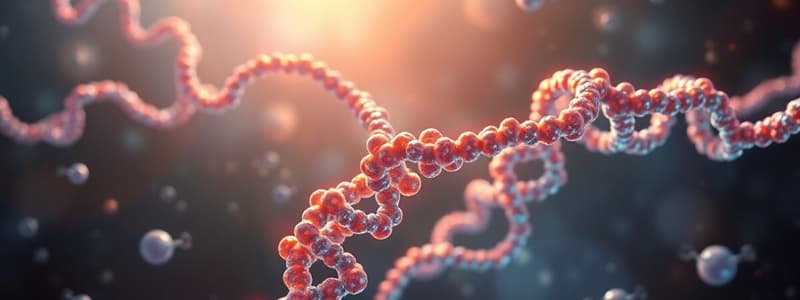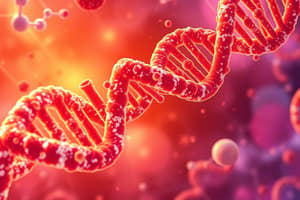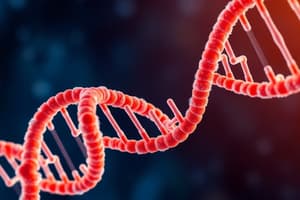Podcast
Questions and Answers
What is the main function of topoisomerases during DNA replication?
What is the main function of topoisomerases during DNA replication?
- Synthesize RNA primers for replication
- Seal nicks in the DNA strand
- Unwind double-stranded DNA (correct)
- Add nucleotides to the growing DNA strand
Which DNA polymerase is primarily responsible for synthesizing the leading strand in eukaryotes?
Which DNA polymerase is primarily responsible for synthesizing the leading strand in eukaryotes?
- DNA polymerase α
- DNA polymerase γ
- DNA polymerase β
- DNA polymerase δ (correct)
Which DNA polymerase is exclusively used for the repair of DNA in eukaryotic cells?
Which DNA polymerase is exclusively used for the repair of DNA in eukaryotic cells?
- DNA polymerase ε
- DNA polymerase α
- DNA polymerase δ
- DNA polymerase β (correct)
What type of activity does DNA polymerase possess to correct mismatched nucleotides during DNA replication?
What type of activity does DNA polymerase possess to correct mismatched nucleotides during DNA replication?
During DNA replication, what distinguishes the synthesis of the leading strand from the lagging strand?
During DNA replication, what distinguishes the synthesis of the leading strand from the lagging strand?
What is the role of RNA primase in DNA replication?
What is the role of RNA primase in DNA replication?
How do DNA helicases contribute to DNA replication?
How do DNA helicases contribute to DNA replication?
Which of the following is NOT a type of DNA polymerase found in prokaryotes?
Which of the following is NOT a type of DNA polymerase found in prokaryotes?
What is the direction of synthesis for the leading strand during DNA replication?
What is the direction of synthesis for the leading strand during DNA replication?
Which of the following enzymes is responsible for the removal of RNA primers during DNA replication?
Which of the following enzymes is responsible for the removal of RNA primers during DNA replication?
What are Okazaki fragments associated with in DNA replication?
What are Okazaki fragments associated with in DNA replication?
In which direction do DNA polymerases read the template strand during replication?
In which direction do DNA polymerases read the template strand during replication?
Which polymerase is primarily responsible for synthesizing the leading strand in prokaryotes?
Which polymerase is primarily responsible for synthesizing the leading strand in prokaryotes?
What is the primary role of DNA ligase during DNA replication?
What is the primary role of DNA ligase during DNA replication?
Which statement accurately describes the function of RNA primers in DNA replication?
Which statement accurately describes the function of RNA primers in DNA replication?
What is a key feature of the lagging strand during DNA replication?
What is a key feature of the lagging strand during DNA replication?
What is the primary function of topoisomerases during DNA replication?
What is the primary function of topoisomerases during DNA replication?
Which statement describes the role of DNA helicases in DNA replication?
Which statement describes the role of DNA helicases in DNA replication?
What is the significance of the primer in DNA replication?
What is the significance of the primer in DNA replication?
What type of topoisomerase creates transient breaks in both strands of the DNA double helix?
What type of topoisomerase creates transient breaks in both strands of the DNA double helix?
Which of the following statements about single-stranded DNA-binding (SSB) proteins is correct?
Which of the following statements about single-stranded DNA-binding (SSB) proteins is correct?
In the context of DNA replication, what distinguishes the leading strand from the lagging strand?
In the context of DNA replication, what distinguishes the leading strand from the lagging strand?
What is the role of DNA polymerases during replication?
What is the role of DNA polymerases during replication?
Which statement accurately reflects the action of Type I topoisomerases?
Which statement accurately reflects the action of Type I topoisomerases?
Flashcards are hidden until you start studying
Study Notes
DNA Replication Enzymes
- DNA polymerases are the main enzymes involved in DNA replication, reading the template DNA in the 3' to 5' direction and synthesizing a new strand in the 5' to 3' direction. They have a proofreading activity, recognizing and removing mismatched nucleotides.
- DNA polymerase I is primarily a repair enzyme for prokaryotes, with both 5' to 3' and 3' to 5' exonuclease activity.
- DNA polymerase III is the primary enzyme for leading and lagging strand synthesis in prokaryotes.
- In eukaryotes, DNA polymerase α is responsible for generating primers, DNA polymerase β is used for repair, DNA polymerase δ is the lead polymerase in DNA synthesis, and DNA polymerase γ functions in mitochondria.
- DNA helicases are essential for unwinding double-stranded DNA.
- DNA primase synthesizes short RNA primers, which are necessary for DNA polymerase to initiate synthesis.
- Nick sealing enzymes are responsible for joining DNA fragments and closing gaps. These include topoisomerases and DNA ligase.
- Single-stranded binding proteins (SSB proteins) bind to single-stranded DNA, preventing re-annealing and protecting the strands from degradation.
DNA Replication Steps
- Separation of the two strands: The two strands of parental DNA must separate for replication. This happens at a specific site called the origin of replication (Ori). In prokaryotes, there is one Ori, while in eukaryotes, there are multiple origins. The unwinding and separation create a "V" shape called the replication fork.
- Formation of RNA primers: DNA primase synthesizes short RNA primers, approximately 10 nucleotides long, complementary to the DNA template strand. Primers are necessary for DNA polymerases to initiate synthesis.
- Formation of two new strands: Both parent strands serve as templates for DNA synthesis, generating two new daughter strands. The DNA polymerases read the template strand in the 3' to 5' direction and synthesize the new strand in the 5' to 3' direction. This process is called semi-conservative replication.
- Leading strand: Synthesized continuously in the 5' to 3' direction toward the replication fork.
- Lagging strand: Synthesized discontinuously in the 5' to 3' direction away from the replication fork, forming short fragments called Okazaki fragments.
- Excision of RNA primer and replacement by DNA: The RNA primers are removed by nucleases (like RNase H in eukaryotes or polymerase I in prokaryotes) and then replaced by DNA nucleotides using another DNA polymerase (polymerase I).
- Joining Okazaki fragments: DNA ligase joins the Okazaki fragments, creating a continuous DNA strand.
- Replication fork movement: Replication forks proceed in both directions away from the origin of replication, resulting in bidirectional replication.
Proteins Required for DNA Strand Separation
- DNA binding protein: Binds to specific DNA sequences at the origin of replication and initiates melting of AT rich regions leading to strand separation.
- DNA helicases: Bind to single-stranded DNA near the replication fork and unwind the helix using ATP.
- Single-stranded DNA-binding (SSB) proteins: Bind to single-stranded DNA, preventing re-annealing and protecting it from degradation. These proteins ensure the DNA is available for the polymerase to synthesize the new strand.
- Topoisomerases: Relieve torsional stress and prevent the extreme supercoiling that would result from unwinding.
- Type I topoisomerases: Cut one strand of the DNA helix, passing the other strand through the break, and then resealing the break.
- Type II topoisomerases (DNA Gyrase): Cut both strands of the DNA helix, allowing the strands to unwind and then resealing the breaks.
Origins of DNA Replication
- In eukaryotes, DNA replication originates at multiple sites spaced every approximately 150 kilobases (kb) along the DNA molecule.
Studying That Suits You
Use AI to generate personalized quizzes and flashcards to suit your learning preferences.




